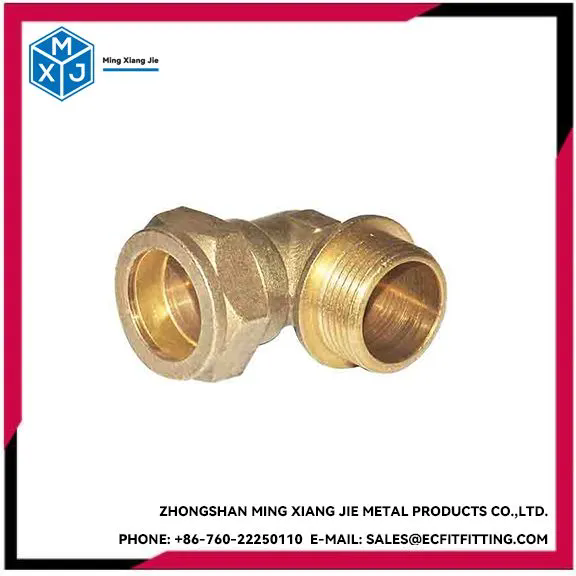What Are Brass Compression Fittings and Why Are They Essential for Plumbing and Piping Systems?
2024-12-12
When it comes to plumbing, HVAC, or other piping systems, one of the most important components that ensures tight and leak-free connections is the fitting. Among the various types of fittings available, brass compression fittings stand out for their reliability, versatility, and ease of use. But what exactly are brass compression fittings, and why are they so commonly used in plumbing, gas, and other fluid-handling systems?
In this blog, we will explore the fundamentals of brass compression fittings, their advantages, applications, and why they are such a popular choice in both residential and industrial settings.
What Are Brass Compression Fittings?
Brass compression fittings are mechanical components used to join two pipes or tubes together. These fittings work by creating a tight seal around the pipe with the help of a compression ring (also known as a ferrule) and a nut. When the nut is tightened, it compresses the ferrule around the pipe, creating a secure, leak-free connection. Brass, an alloy of copper and zinc, is commonly chosen for these fittings because of its strength, corrosion resistance, and malleability.
These fittings are commonly used in both metal and plastic piping systems, where a reliable, durable connection is required without the need for welding, soldering, or threading. Compression fittings can be used for connecting various types of pipes, including copper, steel, and plastic.
How Do Brass Compression Fittings Work?
The mechanics of a brass compression fitting are simple but highly effective. Here’s a step-by-step look at how they function:
1. Insert the Pipe
The pipe or tube is first inserted into the fitting. Depending on the design, the pipe may need to be cut to a precise length to ensure proper fitment within the fitting.
2. Place the Compression Ring (Ferrule)
The compression ring, or ferrule, is placed over the pipe. This ring is typically made of brass or another metal and has a beveled edge that will later form a tight seal around the pipe when the nut is tightened.
3. Tighten the Nut
The nut is then threaded onto the fitting body and tightened with a wrench. As the nut is tightened, the compression ring is forced inward, compressing against the pipe and creating a tight, secure seal.
4. Create a Leak-Proof Joint
The compression of the ferrule creates a strong, leak-proof connection by pressing against the pipe, ensuring that no liquid or gas can escape.
This simple but effective design makes brass compression fittings a go-to choice for many plumbing and piping systems.
Why Choose Brass Compression Fittings?
There are several reasons why brass compression fittings are highly favored in various industries:
1. Durability and Strength
Brass is a strong, durable material that can withstand high pressures and extreme temperatures. This makes brass compression fittings ideal for both domestic and industrial applications, where longevity and performance are critical. They resist corrosion better than many other metals, ensuring that they last for years without compromising their effectiveness.
2. Corrosion Resistance
Brass is highly resistant to corrosion, especially in moist or harsh environments. This is particularly important for plumbing systems, where exposure to water and various chemicals is common. The corrosion resistance of brass helps to prevent leaks and maintain the integrity of the system over time.
3. Easy Installation and Maintenance
Brass compression fittings are relatively easy to install, even for DIY enthusiasts. Unlike soldered or welded connections, which require special tools and skills, compression fittings can be installed with basic hand tools like a wrench. The ease of installation also makes them a practical option for repairs and maintenance, as they can be easily disassembled and replaced if necessary.
4. Versatility
Brass compression fittings are highly versatile and can be used in a wide range of applications. From plumbing systems and heating systems to fuel lines and gas connections, brass compression fittings offer a reliable, leak-proof solution. They are also suitable for both rigid and flexible piping systems, making them adaptable to various needs.
5. Leak-Proof Connection
One of the main advantages of brass compression fittings is their ability to provide a leak-proof seal. This is essential in piping systems where leaks can lead to damage, safety hazards, and costly repairs. The compression mechanism ensures that the pipe is securely fastened, minimizing the risk of leaks.
6. Cost-Effective
While brass compression fittings are durable and reliable, they are also relatively affordable compared to other types of fittings, such as welded or flanged connections. This makes them an economical choice for both small-scale and large-scale projects.
Applications of Brass Compression Fittings
Brass compression fittings are used across various industries for different purposes. Some of the most common applications include:
1. Plumbing Systems
In residential and commercial plumbing, brass compression fittings are often used to connect copper, steel, or plastic pipes. They are ideal for water supply lines, irrigation systems, and even drain lines. The leak-proof connection provided by brass compression fittings ensures safe, efficient water flow in plumbing systems.
2. Gas Lines
Brass compression fittings are also commonly used in gas line installations. Since they create a reliable, tight seal, they are suitable for connecting gas pipes and appliances such as stoves, water heaters, and boilers.
3. HVAC Systems
In heating, ventilation, and air conditioning (HVAC) systems, brass compression fittings help connect refrigerant lines and ensure that the system runs efficiently without any leakage. Their ability to withstand high pressures makes them suitable for both residential and industrial HVAC systems.
4. Automotive and Fuel Systems
Brass compression fittings are used in automotive systems for connecting fuel lines, air lines, and brake systems. They are especially useful in situations where tight, secure connections are required to handle fuel or compressed air.
5. Industrial Applications
Brass compression fittings are also used in various industrial processes, such as in chemical plants, manufacturing facilities, and laboratories. Their ability to handle high pressures and temperatures makes them ideal for these demanding environments.
Are There Any Alternatives to Brass Compression Fittings?
While brass compression fittings are a popular choice, there are alternatives available depending on the specific needs of the system:
1. Stainless Steel Compression Fittings – Stainless steel is another highly durable material used in compression fittings. It is more resistant to corrosion in aggressive environments, such as those involving chemicals or saltwater. However, stainless steel fittings tend to be more expensive than brass.
2. Plastic Compression Fittings – Plastic compression fittings are lightweight and resistant to corrosion, making them suitable for low-pressure, non-toxic applications. They are often used in irrigation or water systems but may not be as durable as metal fittings in high-pressure systems.
3. Copper Compression Fittings – Copper is another material used for compression fittings, particularly in plumbing systems. Copper fittings are corrosion-resistant but may be less durable than brass in certain applications.
Conclusion: Why Brass Compression Fittings Are Essential
Brass compression fittings offer a reliable, cost-effective, and versatile solution for a wide range of plumbing, piping, and fluid-handling applications. Their durability, ease of installation, and ability to create a leak-proof connection make them an essential component in both residential and industrial systems. Whether you’re installing a new plumbing system, repairing an HVAC unit, or working with gas lines, brass compression fittings ensure that the job is done right, with long-lasting results.
Choosing brass compression fittings means investing in quality, efficiency, and safety—key elements for maintaining the integrity of any piping system.



